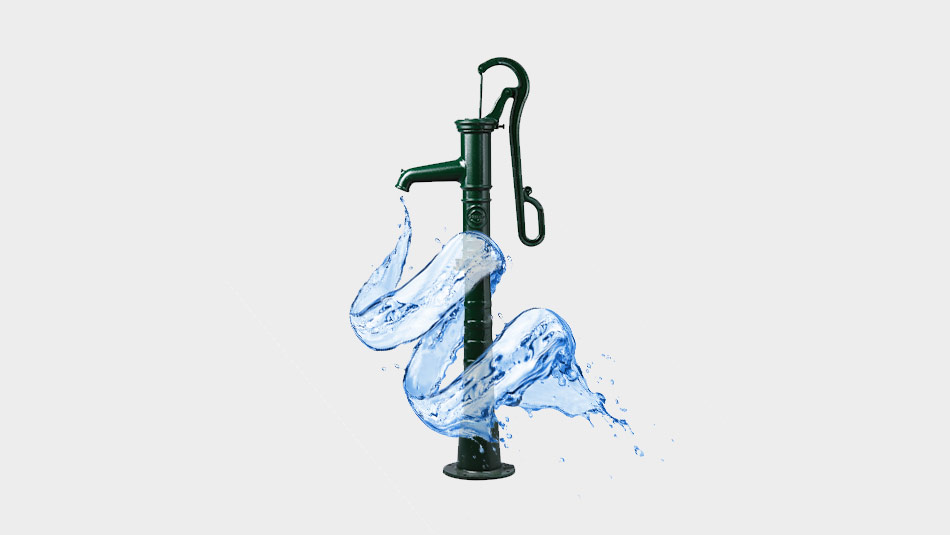How to find the right manual well pump

Everything you need to know to find the right model of manual well pump
Would you like to install a manual pump to recover water from your well and benefit from free water for your garden? Discover the different models of manual pumps. Quick solutions that are easy to install, robust and attractive. Follow our advice to choose a model that is adapted to your needs.
Need advice?
Our team of experts is here to help you.
You can contact us via a simple click:
What is a manual well pump?
How do manual pumps work?
The principle of all hydraulic pumps is to suck in a liquid to discharge it. They transform mechanical energy into hydraulic energy.
Manual pumps use pressure to put a liquid in movement. Indeed, it is the same operating principle as for displacement pumps. This type of water pump operates with a piston. When the handle is activated, the piston rises and creates a depression in the cylindrical chamber. The discharge valve opens and the lower valve closes.
When the piston moves back down, the water rises in the chamber to be evacuated during the next cycle.
The lower valve prevents the loss of prime. The system is generally completed with a strainer whose role is to filter the water on suction.
It is thus a self-priming pump. It is called a surface pump because its proper operation depends on the suction height, which cannot exceed 7 metres. Models for deep wells exist, but the mechanism must be installed in the well itself.
The different models of hand pumps
Manual beam pumps
These hand pumps have many advantages. They stand out for their solidity, ease of installation and use, as well as being inexpensive.
Their only small drawback is that they offer a relatively low yield.
Manual rotary pumps
These pumps are equipped with a rotor and a stator. They are appreciated for the constancy of their volume but only enable small quantities of water to be pumped, especially for shallow depths.
Manual semi-rotary pumps
These are pumps with a flat piston that provide twice the yield of beam pumps.
Their performance depends, among other things, on the speed at which the lever is activated.
Most of our models of manual pumps are made of cast iron. This robust material is not suitable for sub-zero temperatures. We therefore recommend you plan for winterising.
Another option is to remove the pump and place it under shelter for the winter. In this case, remember to drain the system and use the opportunity to service and grease the pump.
What are the criteria to choose the right model of manual pump?
Several factors should be taken into account to choose the most suitable model.
Choose the right size
First, it is essential to know the highest and lowest water levels in the well. You can then measure the distance the water must travel from the inlet to the pump. This is the suction height, and for most Japy manual pumps this cannot exceed 7 metres.
For a height of less than 4 metres, a diaphragm pump is an interesting option.
A semi-rotary pump is ideal when the length of the discharge hose is significant. The longer this length, the smaller the cylinder capacity should be.
Above 7 metres, you should install a well pump, suitable for greater depths. These are immersion pumps that operate via a rod assembly installed at the top of the well.
They must be perfectly aligned to ensure their proper operation. If the well is angled, for example, you will have to consider another model, such as a manual vacuum pump. They are suitable for greater heights. Fitted with flexible discharge hoses, they are also suitable for wells that are not straight.
Choose a model to fit your needs
The choice of the pump depends on the use you intend to make of it. Models differ if you connect them to a garden hose or if you use the pump to directly fill a watering can or bucket.
This factor is essential to determine the required pressure, expressed in bars, and the useful flow rate, indicated in litres/min or m³/h.
What are the characteristics of your water?
This is another important factor. The pumped water can be clear or may contain particles, gravel or larvae. In this case, it is absolutely necessary to install a filtration system .
Aesthetics
There is a wide range of manual surface pumps. Our cast iron pumps possess a vintage style that will enhance your exterior.
Contact us for further information. Tell us about your project and your needs to enable our experts to recommend the most suitable pump for you.
